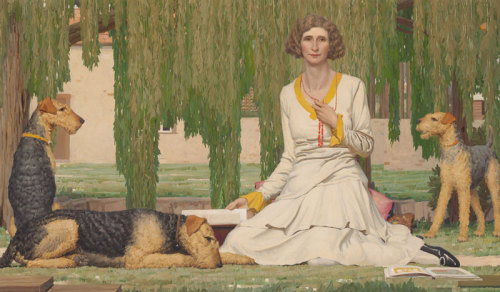The artists in this period experimented with a degree of abstraction, a concern with composition, form and colour, and with a shallow picture plane and cool, crisp precision.
Stella Bowen's portrait of Mary Widney (1927) is rendered in bold lines and depicted from viewer sees the subject in a 3/4 profile and also her image from behind as she is reflected in the mirror.

My new favourite artist is Nora Heysen - ok, she's been around for a while, but she's new to me. I love her London Breakfast (1935) as she sits in her dressing gown, hunched forward over the paper with a tea-cup in hand and the breakfast things still on the table. It's gentle and soft but somehow still honest as I imagine her taking a moment to herself before hurrying on with the day.
 The boy in the bathing trunks in Elise Blumann's Charles, Morning on the Swan (1935) seems to be almost stepping out of the frame. He has no face but lots of form against the rippling sea. The canvas has a flat, patterned surface, and the broad rhythmic brushstrokes and network of hatch marks are clearly visible.
The boy in the bathing trunks in Elise Blumann's Charles, Morning on the Swan (1935) seems to be almost stepping out of the frame. He has no face but lots of form against the rippling sea. The canvas has a flat, patterned surface, and the broad rhythmic brushstrokes and network of hatch marks are clearly visible. Margaret Preston's Flapper (1925) is another favourite. The artist has emphasised the flat patterned surfaces of the clothing set against a shallow picture plane. The subject's rosy cheeks and bright expression suggest she is painted as a progressive young society woman, but her homely woollen dress and knitted tights are at odds with the model of the flash bohemian flapper of the 1920s.
Margaret Preston's Flapper (1925) is another favourite. The artist has emphasised the flat patterned surfaces of the clothing set against a shallow picture plane. The subject's rosy cheeks and bright expression suggest she is painted as a progressive young society woman, but her homely woollen dress and knitted tights are at odds with the model of the flash bohemian flapper of the 1920s. Eric Wilson did not clutter his portraits with background detail. All attention is focused on the subject and the meticulous realism of The atist's mother (1937) is almost photographic in its detail. With her hat and coat on, and her gloves and umbrella in hand, she looks as though she is just about to go out and is only delayed by her son's request to pose.
Eric Wilson did not clutter his portraits with background detail. All attention is focused on the subject and the meticulous realism of The atist's mother (1937) is almost photographic in its detail. With her hat and coat on, and her gloves and umbrella in hand, she looks as though she is just about to go out and is only delayed by her son's request to pose.
In Christian Waller with Baldur, Undin and Siren at Fairy Hills (1932), Napier Waller has painted his wife sitting on the grass with three airedale terriers, beneath the willow trees with books and cushions. She sits fully dressed in stockings and shoes, playing with her necklace. The wide canvas is full of details to the edges - if this were a photograph we would say it was beautifully cropped.
Christian became a book illustrator and printmaker while her husband became a printmaker and worked with murals and mosaics. In the 1930s he began to work almost exclusively in stained glass and mosaics, using a classical and formal style. This was painted at a time when he was becoming a man of the world while she was retreating into an esoteric religion. Knowing that, there seems to be some distance implied in the portrait.
 Roy de Maistre was a pioneer of Australian Post-Impressionism and Abstraction. In his Self Portrait (1945) the central focus is the well-stoked fire, symbolising the belly of the artist, and suggesting a passionate and creative spirit. The bold, flattened forms and intersecting planes show the influence of cubism upon the work.
Roy de Maistre was a pioneer of Australian Post-Impressionism and Abstraction. In his Self Portrait (1945) the central focus is the well-stoked fire, symbolising the belly of the artist, and suggesting a passionate and creative spirit. The bold, flattened forms and intersecting planes show the influence of cubism upon the work.Albert Tucker, on the other hand, was influenced by the Expressionists, whose strong images responded to the social realities of the Depression - he became one of a group of Melbourne artists known as the Angry Penguins. His Self Portrait (1937) reveals a deeply penetrating gaze, foreshadowing the emotionally charged images he produced in the 1940s. The high forehead, swept back hair, mean scarf over jacket and tie, big eyes, sharp nose, full lips, one raised eyebrow, head tilted forward with chin down but eyes up, all combine to produce the effect of a knowing but quizzical look.


















